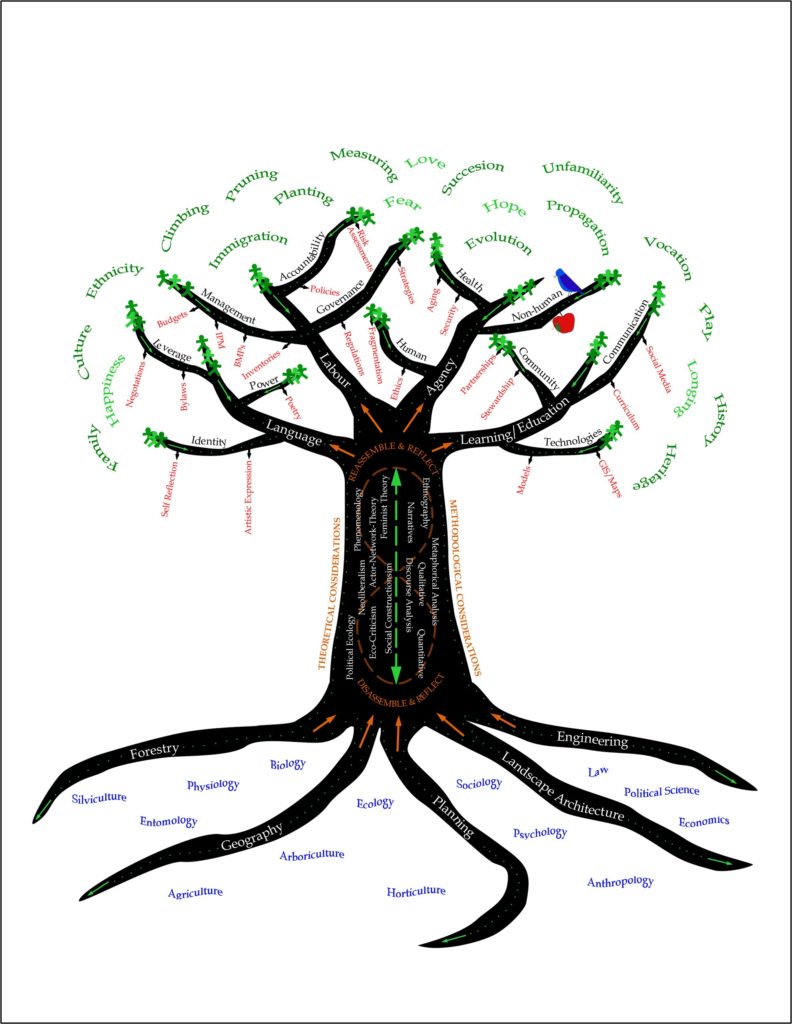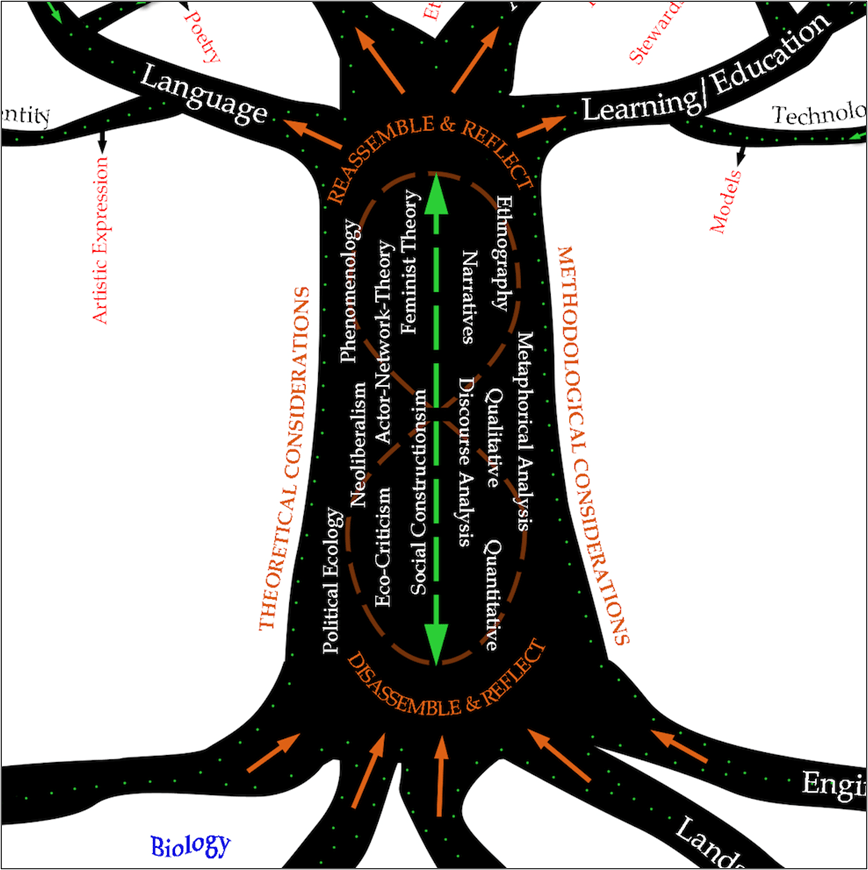Lived Experience, Essential Narratives, Part 2: A Tree Model for Integrating Social Dimensions into Urban Forestry
As published in City Trees magazine, November/December issue.
Modified excerpt from the author’s PhD dissertation, Learning from Limbwalkers: Arborists’ Stories in Southern Ontario’s Urban Forests (Bardekjian, 2015).
Human connections and experiences with trees have inspired creative interpretations and visual representations of our cultures, flow, and processes for centuries using the tree (Lima, 2014). In urban forest research, the most commonly used metaphor or visual depiction using a tree involves the values and benefits of trees or the depiction of photosynthesis.
Drawing on Eisenhardt’s model (1989) that theories can be built from case studies, I propose a new conceptual framework for exploring urban forestry, a tangible tool for future research considerations and practice analysis that can both build upon the strengths that political ecology presents and help overcome its main challenges in studies of urban forestry. In homage to my doctoral research (Bardekjian, 2015) interview participants— urban foresters and field arborists—I chose a deciduous tree to depict my model since most participants identified a red oak (Quercus rubra) as their favoured and respected tree for various reasons. In the following sub-sections, I describe the various parts and functions of this model, so that it may be understood, built upon, and used in future researches.
Based on my research and inspired by my interviewees’ insights, I offer this framework as a concept and visual map to inform work at the research/practice interface. This structure serves a dual purpose: it acts as a conceptual framework for urban forestry as well as a process model for moving forward when considering research (e.g. stronger inclusion of lived experience) and practice (e.g. consideration for social theoretical frameworks). Each component should be considered fluid and cyclical as represented by the dotted infinity symbol and branching systems (Figures 1 and 2). Moving upwards from the roots, taking into account the foundational disciplines of urban forestry with specific canons, then into the stem where critical theoretical insights and methodological considerations are fluid, then upwards into the canopy to consider dominant and alternate narratives, then finally into the more intimate stories and applied outputs; this model shows the multiple layers of social and ecological complexity and their ever-evolving flow within and around one another in urban forestry (Figure 1).


Roots
I have presented the dominant roots in this model using commonly considered foundational fields (Figure 1), but to be clear, there are other disciplines that can be included. Other disciplines that are relevant to urban forestry, but commonly considered foundational, are represented in blue (analogous to water) and feed the roots (dominant disciplines) in a conceptual ebb and flow. I did not represent these as fibrous roots since those would need to be clearly off-shoots of a dominant stem. Rather the portrayal of water flowing around the dominant roots depicts their universality. Current and past research has been informed and framed through the themes of these roots; yet, this model shows that the fields upon which urban forestry is built, or in which urban forestry is rooted, must be considered and disassembled in order to understand its current constraints and opportunities.
Limbs and branches
The dominant limbs are the overarching narratives and themes that embody urban forestry and that active participants in urban forestry contend with, as revealed through my interviews. There can be many more. The point is that these are structural. Where year after year the tree grows new limbs and narratives, the existing ones do not disappear, they become part of the larger process and growth structure. Branches are interconnected and woven. The connections are messy at first glance, but have a chaotic order that offers necessary structure and function for an ever-expanding canopy to provide new ways of seeing and knowing broader narratives.
I have presented the dominant limbs in this model (Figure 1) using the narratives that emerged from my doctoral interviews (e.g. Language, Labour, Agency, Learning/Education), and I have presented the smaller branches as considerations within these larger narratives (e.g. Identity, Leverage, Power, Management, Accountability, Human, Non-human, Health, Communication, Technologies, Community), but to be clear, there are countless possibilities. In addition, the smaller branches that represent subjugated and/or alternative narratives that are shown as offshoots of larger limbs are universal to all the dominant narratives. For example, Leverage and Identity, though presented with Language, are also relevant to the broader Labour narrative/limb.
Leaves
The leaves are the individual, personal stories, experiences, actions, and activities of people, workers, and residents that make up urban forest communities (Figure 1). The leaves represent a child’s first exposure to trees that left an impression, a community’s ties to a heritage tree, a climber’s love of the canopy, or a new immigrant’s experience with unfamiliar species. The leaves here constitute the drivers of those intimate stories that change and grow in both numbers and density from year to year; these stories are countless, and are driven by emotions and constructs, as illustrated by the person-shaped leaves.
To further this metaphor: in autumn, leaves fall and are collected, and new leaves will emerge the following year. This collection process can be applied to stories represented nationally, regionally, and locally, and that comprise what we call natural heritage. It is my position that these narratives are the essence of urban forest (social) memory and thus should be told and re-told. These stories also offer counter-narratives (i.e. opposing perspectives of a similar issue), as my interviews revealed. It is these counter-narratives of lived experience that offer windows into diverse perspectives, where opportunities for further research are possible.
The green arrows and dotted lines (analogous to phloem that transports photosynthates to the rest of the tree) travel through the tree, showing that the stories of lived experience inform the dominant narratives and affect the process and then, in turn, can affect the perceptions of foundational disciplines. Knowledge flows from the leaves down to the roots representing that all nourishment travels both upwards and downwards; this is represented by the green process flows. Given that the leaves are a dominant aspect in practicing urban forestry considerations (i.e. increasing canopy cover)—then arguably these social narratives are equally represented as such.
Fruits
The fruits are the yearly outputs, deliverables, and/or results in and of urban forestry work (Figure 1). These include research endeavours, policies, operational plans, tree inventories, strategies, curriculum plans, artistic impressions—the possibilities are infinite. The fruits of the tree change each year; some are built upon, some are not. The process is represented by the small arrows coming off the smaller branches. Under non-human, I have avoided any diction to better reflect that language is also a construction of the human, and that non-human agency deserves its own depiction as represented by the apple, insect, and bird illustrations. The fruits are produced and then reproduced. The collection process-metaphor can be applied to work outputs represented, nationally, regionally, and locally.
Much like the leaves, fruits are sometimes collected for community benefits—for example, think of the company Not Far From the Tree, a Toronto-based urban fruit collection company that mobilized volunteers to pick fruit from private property. The distribution of the fruit is split in thirds: 1/3 is offered to the tree owner, 1/3 is shared among the volunteers, and 1/3 is delivered by bicycle to be donated to food banks, shelters, and community kitchens in the neighbourhood.
Stem
As a conceptual process model, the stem is fluid (Figure 2). It embodies the theoretical frameworks and methodologies that offer critical insights into analysis and should be considered as xylem and phloem continually moving through the tree to feed and nourish its roots and limbs (think nervous system or veins). The leaves (i.e. stories) provide nourishment (think photosynthesis) and feed the rest. The xylem and phloem receive nutrients from the roots (the foundational fields), and the leaves (stories and drivers of lived experiences) then move through the rest of the tree: this is represented by the orange words and orange arrows and the green dots and green arrows; this fluid process in urban forestry is ubiquitous and constant.
The phrase Disassemble & Reflect at the base of the stem is intended as part of the process to remind users that the normative frameworks of foundational disciplines can be broken down and examined to better understand how interdisciplinarity is woven into or reeved through urban forestry. Similarly, the phrase Reassemble & Reflect at the top of the stem, where the limbs begin, is where the threads are braided back together and then flow into the dominant narratives.
*****
The process model I present here is ultimately a fluid and draft concept that was first seeded when I read T. A. Barron’s The Great Tree of Avalon (2006), then permeated through my readings of scientific literatures and social theories around urban forestry and urban nature. The model is symbolic as a biological organic entity onto itself, or a process depending on the avenue of entry. The visual representation of inclusive concepts, theories, practices, methodologies, and outputs is conceptually inspired by actor-network theory as a process for urban forestry, weaving threads of transdisciplinarity towards effective or transformative change (Ledwith & Springett, 2010).
Like with most conceptual frameworks, there are gaps that must be considered, and other representations than the tree could possibly be used. It is impossible to capture everything that urban forestry constitutes, because it is ever-evolving and a complex and interdisciplinary field with multiple layers: socially, ecologically, economically, and politically. The division of space and distribution of resources are a constant contest. Thus, the tree model figure is helpful in thinking more holistically; but it is also a revolving door.
Acknowledgements
Doctoral Committee: Dr. L. Anders Sandberg, Dr. Cecil Konijnendijk van den Bosch, Dr. Leesa Fawcett, Dr. Don Dippo
References
Bardekjian, A. (2015). Learning From Limbwalkers: Arborists’ Stories in Southern Ontario’s Urban Forests. (Accession No. 10315/30088) [Doctoral dissertation, Faculty of Environmental Studies, York University, Toronto, Ontario]. YorkSpace. Available at: http://hdl.handle.net/10315/30088
Barron, T. (2004). The great tree of Avalon trilogy. (Vols 1-3). New York, NY: Philomel Books.
Eisenhardt, K. (1989). Building theories from case study research. Academy of Management Review, 14(4), 532-550.
Ledwith, M. & Springett, J. (2010). Participatory practice: Community-based action for transformative change. Policy Press.
Lima, M. (2014). The book of trees: Visualizing branches of knowledge. New York, NY: Princeton Architectural Press.
Back to all articles